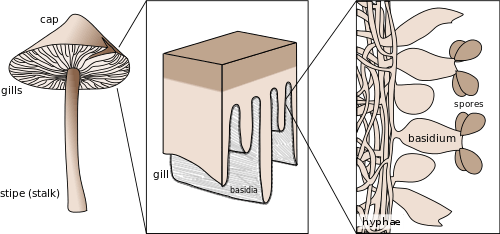Basidium
A basidium (pl., basidia) is a microscopic sporangium (or spore-producing structure) found on the hymenophore of fruiting bodies of basidiomycete fungi which are also called tertiary mycelium, developed from secondary mycelium. Tertiary mycelium is highly coiled secondary mycelium, a dikaryon. The presence of basidia is one of the main characteristic features of the Basidiomycota. A basidium usually bears four sexual spores called basidiospores; occasionally the number may be two or even eight. In a typical basidium, each basidiospore is borne at the tip of a narrow prong or horn called a sterigma (pl. sterigmata), and is forcibly discharged upon maturity.

The word basidium literally means little pedestal, from the way in which the basidium supports the spores. However, some biologists suggest that the structure more closely resembles a club. An immature basidium is known as a basidiole.
Structure
Most basidiomycota have single celled basidia (holobasidia), but in some groups basidia can be multicellular (a phragmobasidia). For instance, rust fungi in the order Puccinales have four-celled phragmobasidia that are transversely septate; some jelly fungi in the order Tremellales have four-celled phragmobasidia that are cruciately septate. Sometimes the basidium (metabasidium) develops from a probasidium, which is a specialized cell which is not elongated like a typical hypha. The basidium may be stalked or sessile.
The basidium typically has the shape of a club, where it is widest at the base of the hemispherical dome at its apex, and its base is about half the width of the greatest apical diameter. Versions where the basidium is shorter and narrower at the base are called "obovoid", and occur in genera such as Paullicorticium, Oliveonia, and Tulasnella. Basidia with a broad base are often described as "barrel-shaped".[1]
Mechanism of basidiospore discharge
In most basidiomycota, the basidiospores are ballistospores—they are forcibly discharged. The propulsive force is derived from a sudden change in the center of gravity of the discharged spore. Important factors in forcible discharge include Buller's drop, a droplet of fluid that can be observed to accumulate at the proximal tip (hilar appendage) of each basidiospore; the offset attachment of the spore to the subtending sterigma, and the presence of hygroscopic regions on the basidiospore surface.
Upon maturity of a basidiospore, sugars present in the cell wall begin to serve as condensation loci for water vapor in the air. Two separate regions of condensation are critical. At the pointed tip of the spore (the hilum) closest to the supporting basidium, Buller's drop accumulates as a large, almost spherical water droplet. At the same time, condensation occurs in thin film on the adaxial face of the spore. When these two bodies of water coalesce, the release of surface tension and the sudden change in the center of mass leads to sudden discharge of the basidiospore. Remarkably, Money (1998) has estimated the initial acceleration of the spore to be about 10,000g.
Successful basidiospore discharge can only occur when there is sufficient water vapor available to condense on the spore.
Evolutionary loss of forcible discharge
Some basidiomycetes lack forcible discharge, although they still form basidiospores. In each of these groups, spore dispersal occurs through other discharge mechanisms. For example, members of the order Phallales (stinkhorns) rely on insect vectors for dispersal; the dry spores of the Lycoperdales (puffballs) and Sclerodermataceae (earth balls and kin) are dispersed when the basidiocarps are disturbed; and species of the Nidulariales (bird's nest fungi) use a splash cup mechanism. In these cases the basidiospore typically lacks a hilar appendage, and no forcible discharge occurs. Each example is thought to represent an independent evolutionary loss of the forcible discharge mechanism ancestral to all basidiomycetes.
References
- Donk, M.A. (1963). "A conspectus of the families of Aphyllophorales". Persoonia. 3 (3): 214.
- Ingold, C.T. 1998. Ballistosporic basidia. The Mycologist 12:50-52.
- Ingold, C.T. 1991. A view of the active basidium in heterobasidiomycetes. Mycological Research 95:618-621.
- Money, N.P. 1998. More g's than the Space Shuttle: ballistospore discharge. Mycologia 90:547-558.
- Pringle, A., S.N. Patek, M. Fischer, J. Stolze, and N.P. Money. 2005. The captured launch of a ballistospore. Mycologia 97:866-871.
External links
- AmericanMushrooms.com: How do fungi reproduce?
- APSnet Illustrated Glossary of Plant Pathology: Basidum
- Demonstrating basidiospore discharge by John Webster. Mycological Society of America Lab Manual
- IMA Mycological Glossary: Basidum
- Spore discharge and dispersal in mushrooms by Heino Lepp, Australian National Botanic Gardens.
- "Using a Microscope: Basidia and Cystidia" by Michael Kuo, MushroomExpert.com